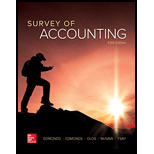
1. What is the difference between
Discuss the difference between accounts receivable and notes receivable.
Explanation of Solution
Receivables:
Receivables refer to an amount to be received in future. General classifications of receivables are accounts receivable, note receivable, and other receivables. Both accounts receivables and note receivable are trade receivables.
Difference between accounts receivable and notes receivable are:
Accounts receivable refers to the amounts expected to be received within a short period from customers upon the sale of goods and services on account. It will arise when customers are allowed to buy now and pay later. Note receivable refers to a written promise for the amounts to be received within a stipulated period of time. This written promise is issued by a debtor or borrower to lender or creditor. Notes receivable includes the maturity date/period, rate of interest.
Accounts receivable have shorter terms to maturity, while notes receivable usually have longer terms to maturity.
Want to see more full solutions like this?
Chapter 5 Solutions
Survey Of Accounting
 College Accounting (Book Only): A Career ApproachAccountingISBN:9781337280570Author:Scott, Cathy J.Publisher:South-Western College PubPrinciples of Accounting Volume 1AccountingISBN:9781947172685Author:OpenStaxPublisher:OpenStax CollegeCentury 21 Accounting Multicolumn JournalAccountingISBN:9781337679503Author:GilbertsonPublisher:Cengage
College Accounting (Book Only): A Career ApproachAccountingISBN:9781337280570Author:Scott, Cathy J.Publisher:South-Western College PubPrinciples of Accounting Volume 1AccountingISBN:9781947172685Author:OpenStaxPublisher:OpenStax CollegeCentury 21 Accounting Multicolumn JournalAccountingISBN:9781337679503Author:GilbertsonPublisher:Cengage



